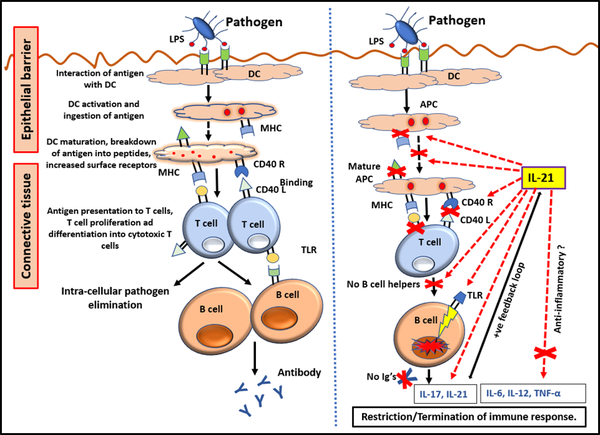-
Home
-
About JCTR
-
Gold Open Access
-
Issues
-
Editorial board
-
Author guidelines
-
Publication fees
-
Online first
-
Special issues
-
News
-
Publication ethics
-
Partners
-
Submit your manuscript
-
Submit your review report
-
Editorial Office
-

This work is licensed under a Creative Commons Attribution-NonCommercial 4.0 International License. ISSN print: 2382-6533 ISSN online: 2424-810X
Volume 7 Issue 1
Comparison of interleukin-21 levels and its correlation with clinical parameters among healthy individuals, chronic periodontitis, and aggressive periodontitis patients
Archana Mootha*, Sankari Malaiappan, Dan M.J. Milstein, Gurumoorthy Karthikeyan, Sheeja S Varghese, N Doraisamy Jayakumar
Mootha et al. J Clin Transl Res 2021; 7(1):7
Published online: February 2, 2021
Abstract
Background: Interleukin-21 (IL-21) has both anti- and pro-inflammatory roles associated with chronic inflammation. It causes tissue destruction by increasing pro-inflammatory cytokines and curbs the activity of certain immune cells that evoke an anti-inflammatory role.
Objective: The aim of this study was to compare IL-21 levels in gingival crevicular fluid (GCF) among patients with generalized chronic periodontitis, aggressive periodontitis, and healthy gingiva and to correlate IL-21 levels with clinical parameters.
Methods: In this cross-sectional case-control study sixty subjects were categorized into 3 groups: healthy gingiva (HG; n = 20), generalized aggressive periodontitis (GAP; n = 20), and generalized chronic periodontitis (GCP; n = 20). IL-21 was measured using ELISA and results were correlated with clinical parameters including plaque index (PI), gingival index (GI), periodontal probing depth (PPD), and clinical attachment level (CAL).
Results: Mean IL-21 levels were 20.0 ± 0.7 in HG, 25.9 ± 0.9 in GCP, and 25.3 ± 1.1 in GAP groups. Significant differences in IL-21 levels were found between HG vs. GAP (p < 0.05) and HG vs. GCP (p < 0.05). No statistically significant difference in IL-21 level was found between GCP vs. GAP. IL-21 levels positively correlated with PPD (r = 0.97) and CAL (r = 0.93) in the GAP group and with PPD (r = 0.92) and CAL (r = 0.96) in the GCP group.
Conclusion: Although periodontitis pathophysiology involves complex interplay between pro-and anti-inflammatory signaling, data on IL-21 revealed elevated levels in both GCP and GAP. Further longitudinal studies are required to characterize and determine the diagnostic value of IL-21 as a reliable biomarker in periodontal disease.
Relevance for patients: Although further longitudinal studies are necessary, interleukin-21 may serve as a potential inflammatory biomarker in screening for generalized chronic and aggressive periodontitis.

DOI: http://dx.doi.org/10.18053/jctres.07.202101.007
Author affiliation
1. Graduate school of Advanced Sciences of Matter, Hiroshima University, Hiroshima, Japan.
2. Department of Periodontics, Saveetha Dental College and hospitals, Chennai, Tamil Nadu, India.
3. Department of Oral Medicine, Academic Centre for Dentistry Amsterdam (ACTA), University of Amsterdam and VU University Amsterdam, Amsterdam, The Netherlands.
4. Department of Periodontics, Saveetha Dental College and hospitals, Chennai, Tamil Nadu, India.
*Corresponding author
Archana Mootha
Graduate School of Advanced Sciences of Matter, Hiroshima University, 1 Chome-3-1 Kagamiyama, Higashi-hiroshima, Hiroshima 739-851, Japan
E-mail: archanamootha@gmail.com
Handling editor:
Michal Heger
Department of Pharmaceutics, Utrecht University, the Netherlands
Department of Pharmaceutics, Jiaxing University Medical College, Zhejiang, China

